#usf contemporary art museum
Text
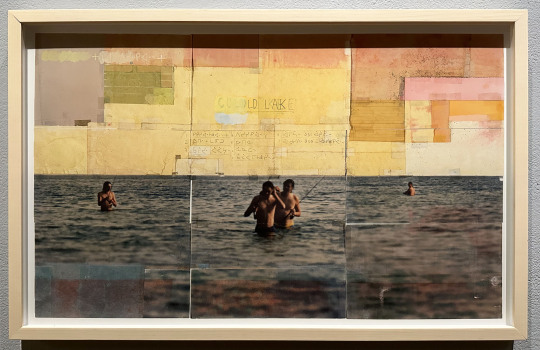
Kimowan Metchewais, “Cold Lake Fishing”, 2004/06

Koyoltzintli, “Gathering Roots” and “Spider Woman Embrace”, Abiquiú, New Mexico, 2019, from the series MEDA, 2018/19, Archival pigment print
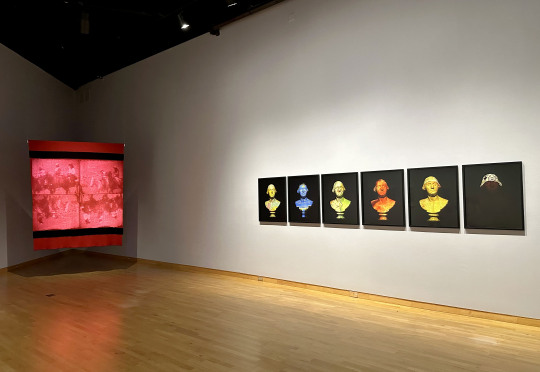
(Alan Michelson “Hanödagayas (Town Destroyer): Whirlwind Series”, 2022 Archival pigment prints and “Pehin Hanska ktepi (They Killed Long Hair)”, 2021 Single-channel video installation: wool blanket and video projection; 1:05 minutes (looped), no sound)
Currently at the USF Contemporary Art Museum is Native America: In Translation curated by Wendy Red Star and organized by Aperture. The work included offers viewers a chance to discover new perspectives on the Native American experience.
From the museum-
“The ultimate form of decolonization is through how Native languages form a view of the world. These artists provide sharp perceptions, rooted in their cultures.” —Wendy Red Star
Native America: In Translation assembles the wide-ranging work of nine Indigenous artists who pose challenging questions about identity and heritage, land rights, and histories of colonialism. Probing the legacies of settler colonialism, and photography’s complex and often fraught role in constructing representation of Native cultures, the exhibition includes works by lens-based artists offering new perspectives on Indigenous identity, reimagining what it means to be a citizen in North America today.
Works included in the exhibition address cultural and visual sovereignty by reclaiming Native American identity and representation. Honoring ancestral traditions and stories tied to the land, Koyoltzintli (Ecuadorian-American, b. 1983) reflects on how the landscape embodies traditional knowledge, language, and memories. Nalikutaar Jacqueline Cleveland’s (Yup’ik, b. 1979) photographs of contemporary tribal communities in western Alaska document Native foraging and cultural traditions as a form of knowledge passed through generations. Revealing stories of trauma and healing, Guadalupe Maravilla (American, b. El Salvador, 1976) communicates autobiographical and fictional narratives informed by myth and his own migration story.
Expanding Indigenous archives and collective memory through photographic means, works by the late artist Kimowan Metchewais (Cree, Cold Lake First Nations, 1963–2011), drawn from his personal archive of Polaroid photographs, construct self-realized Native imagery challenging the authority of colonial representation. Excavating repressed colonial histories of invasion and eviction, Alan Michelson (Mohawk, Six Nations of the Grand River, b. 1953) reinterprets and repositions archival material to redress history from an Indigenous perspective. Marianne Nicolson’s (Musgamakw Dzawada’enuxw First Nations, b. 1969) light-based installation projects Dzawada’enuxw tribal symbols of authority and power onto colonized spaces to contest treaties that imposed territorial boundaries on Indigenous lands. Duane Linklater (Omaskêko Ininiwak from Moose Cree First Nation, b. 1976) reconfigured the pages sourced from a 1995 issue of Aperture, featuring Indigenous artists, creating space for artistic improvisation and reinvention across generations.
Reflecting on performative aspects of Indigeneity and the colonial gaze, Martine Gutierrez’s (American, b. 1989) series of photographs reinterpret high-fashion magazine spreads with a revolving roster of identities and narratives to question Native gender and heritage. Working across performance and photography, Rebecca Belmore (Anishinaabe, Lac Seul First Nation, b. 1960) creates powerful reenactments of past performances incorporating organic materials that reference knowledge, labor, and care of the Earth in defiance of state violence of Indigenous people.
This exhibition closes 12/1/23.

Rebecca Belmore, “matriarch”, 2018, and “mother” from the series “nindinawemaganidog (all of my relations)”, 2018, Archival pigment prints

Photos by Rebecca Belmore and Installation by Marianne Nicolson
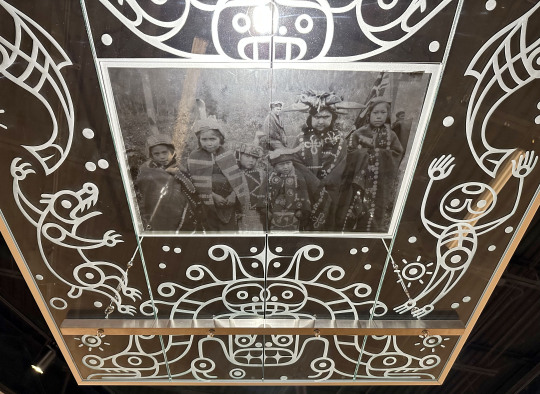

Marianne Nicolson’s installation detail
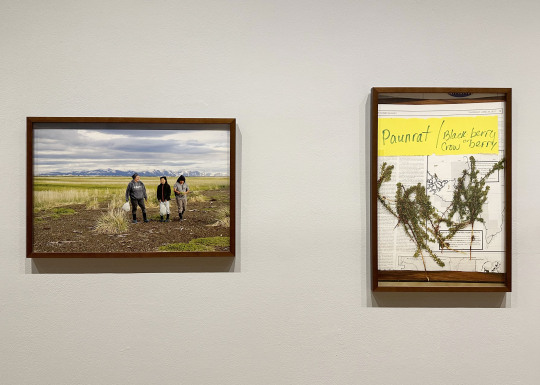
Nalikutaar Jacqueline Cleveland, “Molly Alexie and her children after a harvest of beach greens in Quinhagak, Alaska”, 2018 and “There are two main Yup’ ik names for crowberries or blackberries in Alaska, “paunrat” and “tangerpiit””, 2017, Archival pigment prints

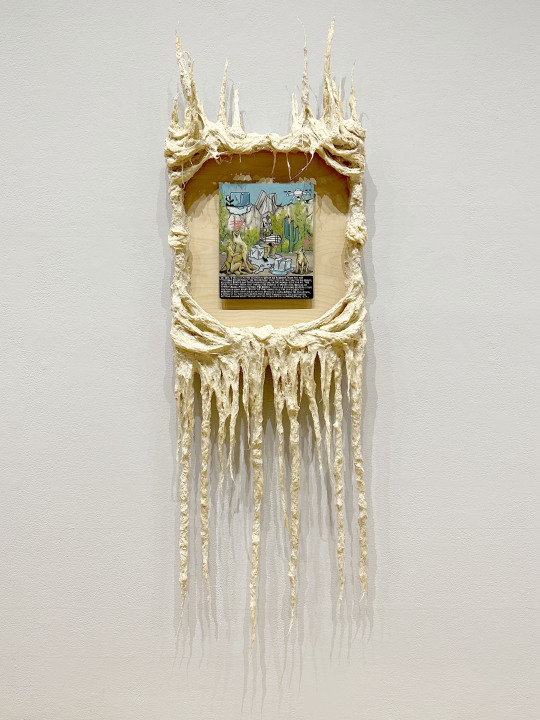
Guadalupe Maravilla, “I Crossed the Border Retablo”, 2021, Oil on tin, cotton, glue mixture, wood
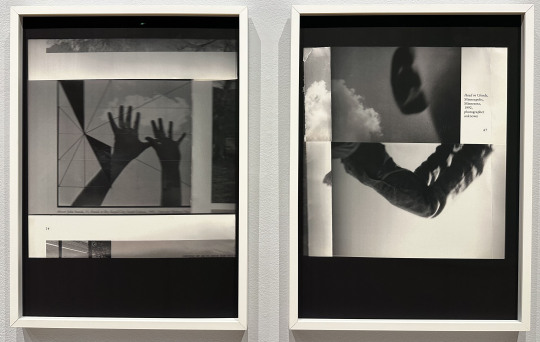

Duane Linklater, “ghost in the machine”, 2021, Archival pigment prints
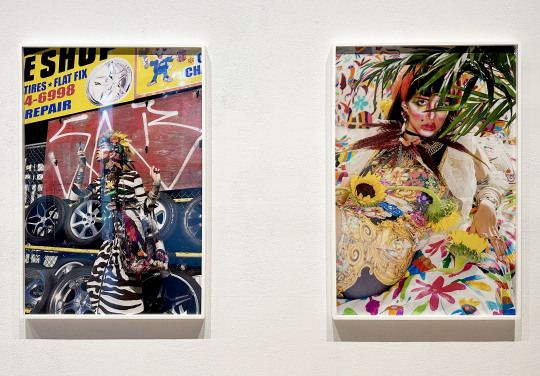
Martine Gutierrez, “Queer Rage, Dear Diary, No Signal During VH1’s Fiercest Divas”, and “Queer Rage, THat Girl Was Me, Now She’s A Somebody”, 2018. digital chromogenic print

One of Kimowan Metchewais’ polaroids from the slide show
#USF Contemporary Art Museum#Native American Artists#Rebecca Belmore#Kimowan Metchewais#Alan Michelson#Martine Gutierrez#Institute For Research in Art#Marianne Nicolson#Duane Linklater#Koyoltzintli#Guadalupe Maravilla#Nalikutaar Jacqueline Cleveland#Mixed Media#Mixed Media Art#Art#Mixed Media Photography#Native American#Native American Art#Native American Heritage Month#Black and White Photography#Art Shows#Florida Art Shows#Native American History#Photography#Polaroid#Polaroid Photography#Tampa Art Shows
3 notes
·
View notes
Text
GENERATOR: USFCAM presents inaugural exhibition SUPERFLEX

Inside the GENERATOR gallery doors is the first piece of the exhibition which also bears its title.
The University of South Florida’s College of the Arts Contemporary Art Museum now straddles Tampa Bay. Since 1989 the USF Tampa campus has filled its Contemporary Art Museum with both visiting artist and student exhibitions, and now on the other side of the bay USF St. Petersburg hosts an extension of the museum in Harbor Hall called GENERATOR. The goal for this branch is to function as an incubator of ideas and a place for expanded artistic experimentation.
The inaugural exhibition at GENERATOR is “SUPERFLEX: This Is The Tip Of The Iceberg”, curated by Sarah Howard and on loan from the Danish artist group SUPERFLEX and Galería OMR in Mexico City. This immersive installation is made up of large-scale mixed-media designs aimed to prompt reflection on the reality and consequences of climate change. Issues like these are particularly relevant to residents here in South Florida, many of whom live mere feet above sea level.
Gallery assistant Neha Mitra explained that it is a two-piece exhibition. Upon entering the gallery doors viewers find themselves facing a glowing neon blue sign bearing the title of the exhibition. Through the curtains just beyond visitors stand in a dark room where a video plays. “As you enter the space you see an animation of a thing that not many people know what it is. It’s a siphonophore, this kind of jellyfish-like creature and essentially what it does is it comes up to the surface at night and cleans up all the carbon in the atmosphere. It's bioluminescent so sometimes if you go out in the harbor you can see it if you’re lucky,” Mitra said. Excess atmospheric carbon levels are one of the main driving forces behind global warming. This is why the siphonophore’s role of removing CO2 from the atmosphere is vital not only for oceanic but global ecosystems alike. “They are super crucial for our survival,” said SUPERFLEX co-founder Bjørn Christiansen during a lecture delivered at Harbor Hall last month.
The video, titled “Vertical Migration,” was originally projected 500 feet high onto the United Nations Secretariat Building in New York City during the 76th United Nations General Assembly in 2021 in order to highlight the critical nature of biodiversity and more generally the importance of recognizing and acting upon the issue of climate change. “The topic (of the UN meeting) was biodiversity. Humans cannot just sit there alone and discuss biodiversity. So we took one of those creatures that we met…We went down and filmed at night and decided we wanted to create an animation based on real footage,” Christiansen said.
‘Vertical Migration” and the Tip Of The Iceberg exhibition are truly at the intersection of art and activism. To experience the installation yourself head over to Harbor Hall before the exhibition leaves on November 22.
0 notes
Text
8 ways to celebrate Native American Heritage Month and ART’N Month in Tampa Bay this November
November is Native American Heritage Month and ART’n Month. Here are eight ways to celebrate in Tampa Bay.
1. Watch The Dali’s “Coffee with a Curator: The Cultural Legacy of Native American Artists” on YouTube.
The Dali started November by inviting James Museum curators Emily Kapes and Ernest Gendron to discuss Native American art in the James Museum collection as part of their “Coffee with a Curator” series. In the talk, they share work from contemporary Native American artists Tammy Garcia, Allan Houser, Preston Singletary, and Victoria Standing Bear Conroy, all of whom are represented in the James Museum’s permanent collection.
2. Go see Tammy Garcia, Allan Houser, Preston Singletary, and Victoria Standing Bear Conroy’s work at The James Museum of Western & Wildlife Art in St. Pete.
I’d be surprised if you didn’t want to see the art in person after hearing about it in the talk (see #1).
While you’re there, don’t miss “From Far East to West: The Chinese American Frontier” which I recently reviewed for Creative Loafing.
3. Experience “Native America: In Translation” via USF CAM.
Wendy Red Star assembled a stellar collection of work from Native American lens-based artists for NYC-based photography magazine Aperture, published in Fall 2020.
Two years later, the collection started traveling the U.S. as “Native America: In Translation.”
Through the end of November, Tampa Bay residents can experience “Native America: In Translation” at the University of South Florida’s Contemporary Art Museum for free (although you will have to drop a couple bucks for parking on ParkMobile).
USF CAM host three special events in conjunction with the exhibition — an indigenous perspectives forum at Barness Hall on Sat. Nov. 4 at 11 a.m., a free film screening of Night Raiders on the lawn Thurs. Nov. 9 and 6:30 p.m., and student led exhibition tours on Thurs. Nov. 30 at 6 and 7 p.m.
4. Attend Creative Pinellas’ Arts Annual Event.
Creative Pinellas’ Arts Annual is ART’n month’s flagship event. This month-long art party + art festival + art exhibition, held at Creative Pinellas in Largo, is the best way to get to know Pinellas County’s arts scene. The party starts Nov. 9, 6-9 p.m.
5. Explore Pinellas County’s arts scene via Creative Pinellas’ ART’n Month scavenger hunt
The second-best way to get to know Pinellas County’s art scene is to participate in Creative Pinellas’ ART’n Month scavenger hunt. The hunt takes participants to art museums, galleries, and public art throughout Pinellas County. All you need do to participate is download the Scavify Scavenger Hunt app on your cell phone, sign up, and start ticking off tasks. I’m documenting the hunt for Creative Pinellas this month, so reach out via social media if you’re participating.
6. Stay in and stream PBS’s Native American & Alaska Native Heritage Month programming. In addition to several documentaries, PBS’s Native American and Alaska Native Month programming leads you into Native American kitchens in “Alter-NATIVE Kitchen” and takes you on a journey of self-discovery with Bezhig Little Bird in the 6-episode series “Little Bird.”
7. Read this month’s issue of Arts Coast Magazine. If you haven’t read Creative Pinellas’ Arts Coast Magazine, now’s a great time to start. It only exists online, but it’s free to read, and it’s organized into categories reflecting the great variety of arts we have in Pinellas County. I wrote stories for the Arts & Education, Literary Arts, and Visual Arts & Film categories this month. But my content is only a small fraction of what’s available to read when you click on the link below.
8. Take a fun online quiz to help you plan your Arts Coast Adventure. If this seems like a lot, that’s probably because it is. There’s always a lot of great art happening in the Tampa Bay area, which is why Creative Pinellas created their Arts Navigator. Click on the link below, take the quiz, and the Arts Navigator will plan a custom Arts Coast Adventure for you. Even if you don’t do the adventure, you should take the quiz. It asks you fun questions like what your spirit animal is.
0 notes
Photo

The Visible Turn: Contemporary Artists Confront Political Invisibility
#000 Years#130#artmaking is making the invisible visible#Bosco Sodi#College of The Arts#Dr. Allen Root#Encyclopedia of Invisibility#Gyge’s Ring#Plato#Stanton Storer Embrace the Arts Foundation#The Gobioff Foundation#The Republic#The Visible Turn#The Visible Turn: Contemporary Artists Confront Political Invisibility#USF Contemporary Art Museum#USF World
1 note
·
View note
Photo

Memento (Lag Wagon), Christian Marclay, 2008, Brooklyn Museum: Contemporary Art
Christian Marclay. Courtesy of the artist, Graphicstudio/USF and Paula Cooper Gallery, New York. Photograph: Will Lytch
Size: Sheet: 51 1/2 x 99 in. (130.8 x 251.5 cm) Frame: 55 x 102 1/2 in. (139.7 x 260.4 cm)
Medium: Cyanotype
https://www.brooklynmuseum.org/opencollection/objects/186420
7 notes
·
View notes
Photo

The USF Contemporary Art Museum (CAM) will continue its year long flag presentation, “Pledges of Allegiance,” with a new flag by artist Alex Da Corte.
1 note
·
View note
Text
Notions of visibility at CAM; Akiko Kotani's crocheted waterfall and four shows at DFAC
USF's Contemporary Art Museum will open another thought-provoking, ... Tavares Strachan's installation, 130,000 Years, takes on the concept of ...
1 note
·
View note
Photo
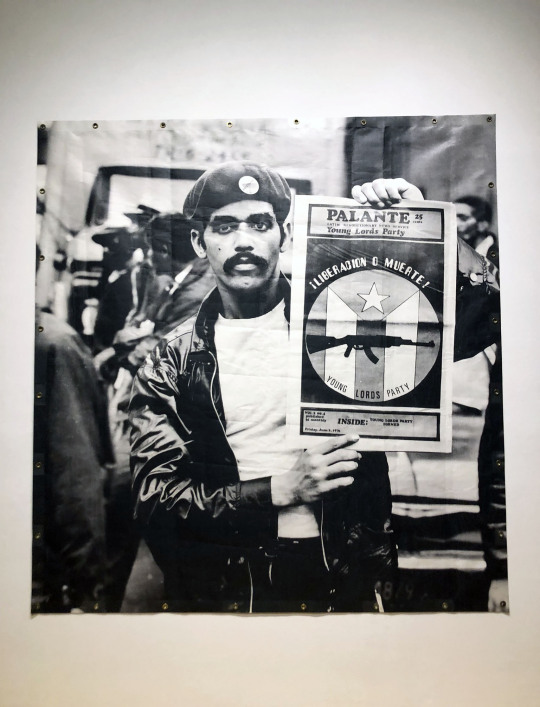

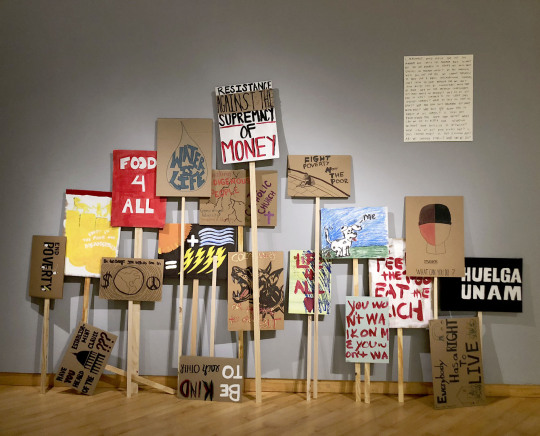
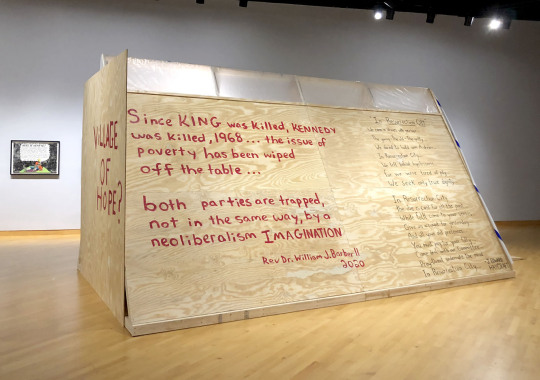

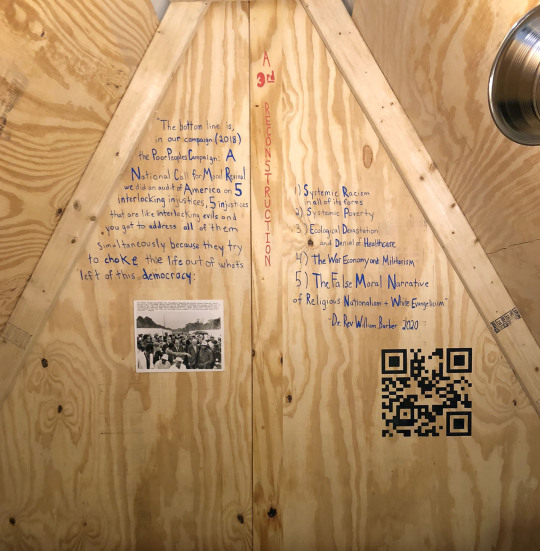
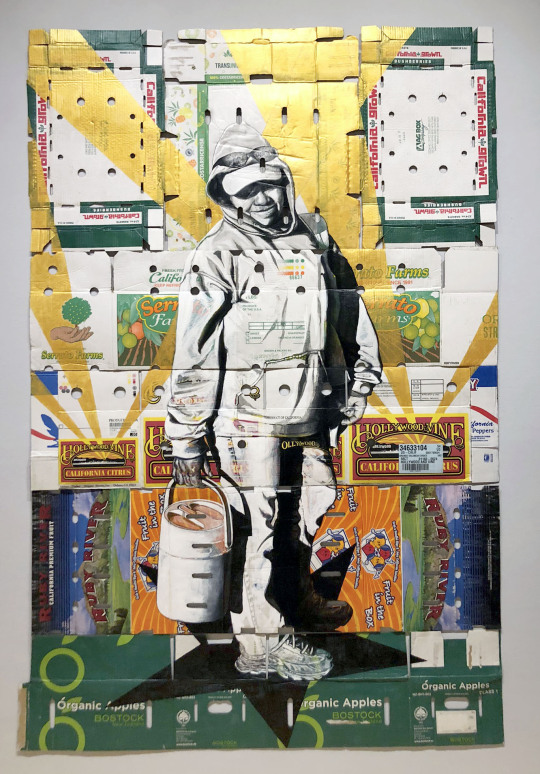


Poor People’s Art: A (Short) Visual History of Poverty in the United States at USF Contemporary Art Museum in Tampa uses installations and artworks to tell the story of, and expand perspectives on, The Poor People’s Campaign- from its origins in the late 1960s to the present day form, as well as comment on poverty and other social issues. Both educational and engaging, it shows that despite long struggles and some progress, we are still very far from much needed social change, especially in regards to poverty.
The museum also produced a free full color, 48 page workbook that you can pick up there or download as a PDF that can be downloaded from their website.
From the gallery’s website-
Dr. Martin Luther King Jr. is well known for his “I Have a Dream” speech, yet much less emphasis is placed on his campaign to seek justice for America’s poor, “The Poor People’s Campaign.” This was a multi-cultural, multi-faith, multi-racial movement aimed at uniting poor people and their allies to demand an end to poverty and inequality. Fifty-three years after Dr. King’s death, the Reverend William Barber II launched a contemporary push to fulfill MLK’s ambitious brief — one that calls for a “revolution of values” that unites poor and impacted communities across the country. The exhibition Poor People’s Art: A (Short) Visual History of Poverty in the United States represents a visual response to Dr. King’s “last great dream” as well as Reverend Barber’s recent “National Call for Moral Revival.”
With artworks spanning more than 50 years, the exhibition is divided into two parts: Resurrection (1968-1994) and Revival (1995-2022). Resurrection includes photographs, paintings, prints, videos, sculptures, books, and ephemera made by a radically inclusive company of American artists, from Jill Freedman’s photographs of Resurrection City, the tent enclave that King’s followers erected on the National Mall in 1968, to John Ahearns’ plaster cast sculpture Luis Fuentes, South Bronx (1979). Revival offers contemporary engagement across a range of approaches, materials, and points of view. Conceived in a declared opposition to poverty, racism, militarism, environmental destruction, health inequities, and other interlocking injustices, this exhibition shows how artists in the US have visualized poverty and its myriad knock-on effects since 1968. Participating artists include John Ahearn, Nina Berman, Martha De la Cruz, Jill Freedman, Rico Gatson, Mark Thomas Gibson, Corita Kent, Jason Lazarus, Miguel Luciano, Hiram Maristany, Narsiso Martinez, Adrian Piper, Robert Rauschenberg, Rodrigo Valenzuela, William Villalongo & Shraddha Ramani, and Marie Watt.

From the museum’s wall plaque about the images from the artists above-
A multimedia visual artist whose work explores themes of history, popular culture, and social justice, Miguel Luciano revisits the history of the Young Lords, a revolutionary group of young Puerto Rican activists who organized for social justice in their communities beginning in the late 1960s. Luciano’s first contribution to Poor People’s Art is a vinyl banner from the public art project Mapping Resistance: The Young Lords in El Barrio (2019), a collaboration with artist Hiram Maristany. It features the photograph “Young Lords Member with Pa’lante Newspaper (1970)” by Maristany, who was the official photographer of the Young Lords and a founding member of the New York chapter. This banner, along with nine other enlarged Maristany photographs, were installed throughout East Harlem at the same locations where their history occurred 50 years prior.
Luciano’s second contribution to Poor People’s Art is the sculpture The People’s Pulpit (2022), a repurposed vintage pulpit from the First Spanish Methodist Church in East Harlem. The Young Lords famously took over the church in 1969 and renamed it “The People’s Church”; they hosted free breakfast programs, clothing drives, health screenings, and other community services there. In this exhibition, The People’s Pulpit features an historic recording of Nuyorican poet Pedro Pietri reciting the celebrated poem Puerto Rican Obituary during the Young Lord’s takeover of The People’s Church.
The central sculpture in the second photo-
Afro-Taino artist Martha De la Cruz fashioned her sculptural installation Techo de sin (Roof of Without), 2021, from stolen, scavenged and donated materials found in Southwest Florida. According to the artist, “Florida is home to a large population of Latin American migrants who have ended up in the US largely due to economic pressures, exploitation and veins of power etched by Europe and the US.” Her powerful work deals with the results of this disjunction and the “symptoms thereabouts (e.g. houselessness, fugitiv-ity, government corruption, and income disparity, etc.).” According to De la Cruz, the word “sin” is a common Dominican mispronunciation for the word “zinc.” The sculpture is animated by a single light bulb that turns on for just ten minutes a day.
From the wall plaque about the Lazarus installation (structure in the 3th, 5th and 6th photos)-
Jason Lazarus’s sculptural installation Resurrection City/Poor People’s Campaign: A National call for Moral Revival/A Third Reconstruction (2023) is anchored in the artist’s historical research and several key photographs of Resurrection City. A tent-like shelter inspired by the temporary residences that populated the 1968 mass protest, the interactive sculpture contains simple sleeping quarters and a curated library filled with physical literature and ephemera centered on both the 1968 Poor People’s Campaign and the 2018 Poor People’s Campaign: A National Call for Moral Revival, co-led by Rev. Dr.William Barber and Rev. Dr. Liz Theoharis.
The library allows for audiences to trace, listen, and talk about the history of advocating for the poor, from 1865 to the present. Additionally, the artist provides a custom transcription (and a QR hyperlink) to Barber’s 49-minute address on the syndicated radio show “The Breakfast Club” in which he carefully outlines his powerful vision for how we might address poverty going forward.

About Jill Freedman’s photograph above-
In the spring of 1968, the talented young street photographer Jill Freedman quit her day job as a copywriter in New York City to join the Poor People’s March on Washington. Freedman lived in Resurrection City for the entire six weeks of the encampment’s existence, photographing its residents as they rallied, made speeches, protested in front of government buildings, confronted police, built makeshift kitchens, organized clothing swaps, and dealt with flooding, petty crime, and illness. One of the most important postwar documentarians, and one of the few women photographers of the era, Freedman captured it all. Freedman’s 2017 book, Resurrection City, 1968-from which this exhibition draws a dozen powerful images-showcases the photographs that she made as a participant in the original Poor People’s Campaign. In multiple ways, Freedman’s images are the sympathetic perch upon much of which much of the present exhibition loosely hangs.
This exhibition closes 3/4/23.
#usf contemporary art museum#tampa art shows#poor people's campaign#poor people's art#miguel luciano#hiram maristany#martha de la cruz#jill freedman#narsiso martinez#jason lazarus#art installation#social issues#art#art shows#poverty#mark thomas gibson#rico gatson#florida art shows#photography#sculpture#drawing
13 notes
·
View notes
Text
WEEKEND ARTINGS: Hocus Focus, Ghost Stories, and more
Art events turn freaky as spooky season approaches. But that's not all. This weekend also brings a tunnel of lights to Sparkman Wharf, Generator's first exhibition to USF St. Pete, and another Art Walk to Gulfport.
Here's what's happening on the art front this weekend:
Writers share ghost stories inspired by the art at Florida CraftArt in St. Pete. Thurs. Oct. 5, 6 p.m.
Fairground's Halloween experience, Hocus Focus, opens Thurs. Oct 5 in St. Pete. Through Nov. 6.
Off-Central hosts the world premiere of Ghost Stories From Yellowstone, an original play about facing one's demons, in St. Pete. Oct. 5-15.
Tampa Repertory Theatre and ThinkTank Theatre return to the Salem witch trials of 1692 in the Arther Miller classic, The Crucible. At Stageworks in Tampa through Oct. 15.
Sparkman Wharf hosts DUNE, a tunnel of lights by Studio Roosegaarde in Water Street Tampa. Oct. 6-29.
Brenda McMahon Gallery celebrates breast cancer warriors at Gulfport's First Friday Art Walk. Oct. 6, 6-9 p.m.
FreeFall Theatre stages the world premiere of horror comedy "Nightsweats" in St. Pete. Oct. 6-Nov. 5.
GENERATOR hosts its first exhibition, “SUPERFLEX: This is the Tip of the Iceberg” at USF St. Petersburg. Oct. 6-Nov. 22.
St. Pete gallery The Werk showcases locally-made surreal art in “Touched by a Lobster." Oct. 6-Nov. 24. Opening Reception Fri. Oct. 6, 5-9 p.m.
The Studio@620 hosts a Harvey Drouillard retrospective. Oct. 7-30.
0 notes
Photo

I am honored to have included in this years Skyway exhibition at the USF Contemporary Art Museum @irausf. It is always meaningful to show with artists that you admire and are inspired by. I am humbled by the work of the fantastic team at CAM, led by the thoughtful curation of @__sarah_howard__ . Thank you for the trust and opportunity. If you are in the area please make an appointment to see this exhibition. . . . . #skyway #contemporaryart #installationart #printmaking #mixedmedia #worksonpaper #soundsart #sculpture #postminimalism #usf #skywayartists (at USF Contemporary Art Museum) https://www.instagram.com/p/CQY9syOly72/?utm_medium=tumblr
#skyway#contemporaryart#installationart#printmaking#mixedmedia#worksonpaper#soundsart#sculpture#postminimalism#usf#skywayartists
0 notes
Video
youtube
With his Pledges of Allegiance flag raised right now dozen locations across the country, Pedro Reyes has a message for the members of his People's United Nations.
"Hands On With A Vision" is on view at: Creative Time HQ; 21c Museum Hotel Durham; California College of the Arts; USF Contemporary Art Museum; Museum of Contemporary Art Detroit; RISD Museum; KMAC Museum; Herbert F. Johnson Museum of Art; Texas State Galleries; The Commons, in partnership with the Spencer Museum of Art, University of Kansas; The Union for Contemporary Art; and Zimmerli Art Museum at Rutgers University.
🎥 by César Martinez, Creative Time’s Leonhardt Cassullo Video Fellow
10 notes
·
View notes
Photo

https://lifeduringwartimeexhibition.org/kalup-linzy @tulsaartistfellowship #Repost @davidcastillogallery • • • • • • USF Contemporary Art Museum Kalup Linzy's work is now available to view in "Life During Wartime: Art in the Age of Coronavirus" in the USF Contemporary Art Museum's virtual viewing space! Pictured is a video still from Kalup Linzy's "I Put a Spell on You from Paula Sungstrong Legend Recordings", 2019. Visit @irausf's virtual exhibition online at lifeduringwartimeexhibition.org/ and learn more about Linzy on the artists page of our website. #KalupLinzy #contemporaryart #contemporaryartist #USF #virtualexhibition #miami #tampa #southflorida #davidcastillogallery #2020tulsaartistfellowship #2020tulsaartistfellow #videoart #performanceart #performance (at USF Contemporary Art Museum) https://www.instagram.com/p/CCqf6Fgl9Jg/?igshid=1e7mv8vhm5qug
#repost#kaluplinzy#contemporaryart#contemporaryartist#usf#virtualexhibition#miami#tampa#southflorida#davidcastillogallery#2020tulsaartistfellowship#2020tulsaartistfellow#videoart#performanceart#performance
0 notes
Photo
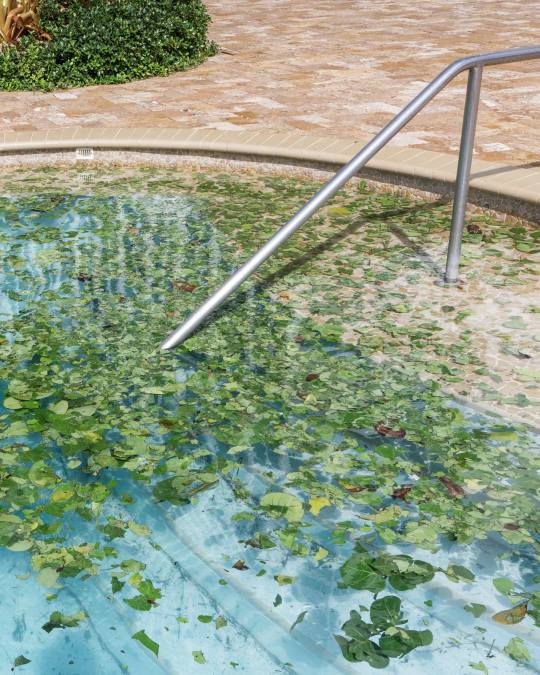
LAST WEEK TO SEE “ANASTASIA SAMOYLOVA: FLOODZONE” AT THE USF CONTEMPORARY ART MUSEUM IN TAMPA
Miss Rosen for Document Journal
Madame de Pompadour’s foreboding epigram, “Après nous, le déluge” (“After us, the flood”), has become eerily sinister in light of climate change. The excesses of Western modernism rival that of the court of Louis XIV—only this time the vast accumulation of wealth and wastefulness are rapidly decimating not just the peasantry but the planet and the very life it supports.
The United States may desperately need a wall—but the last place it should be located is inland, along the desert keeping asylum seekers out. In a June 2019 report, the Center for Climate Integrity predicted the nation needs to build seawalls along 50,000 coastal miles across 22 states by the year 2040 to stave off the impact of rising sea levels. Estimated to cost $400 billion in total, Florida, the most at-risk state, faces costs of $76 billion alone.
Read the Full Story at Document Journal
Photo: Anastasia Samoylova
0 notes
Text
Showing: Robert Lazzarini – “The Return Of The Real” @ USF Contemporary Art Museum
On view through December 7th at the in USF Contemporary Art Museum in Tampa Bay, The Return Of The Real features the eye bending work of Robert Lazzarini (and Rodrigo Valenzuela). The New York-based artist distorts reality with his sculptural “re-presentations”, encouraging viewers to question what they’re seeing in our “era increasingly dominated by fabricated fears, alternative facts […]
The post Showing: Robert Lazzarini – “The Return Of The Real” @ USF Contemporary Art Museum appeared first on AWorkstation.com.
source https://aworkstation.com/showing-robert-lazzarini-the-return-of-the-real-usf-contemporary-art-museum/
0 notes